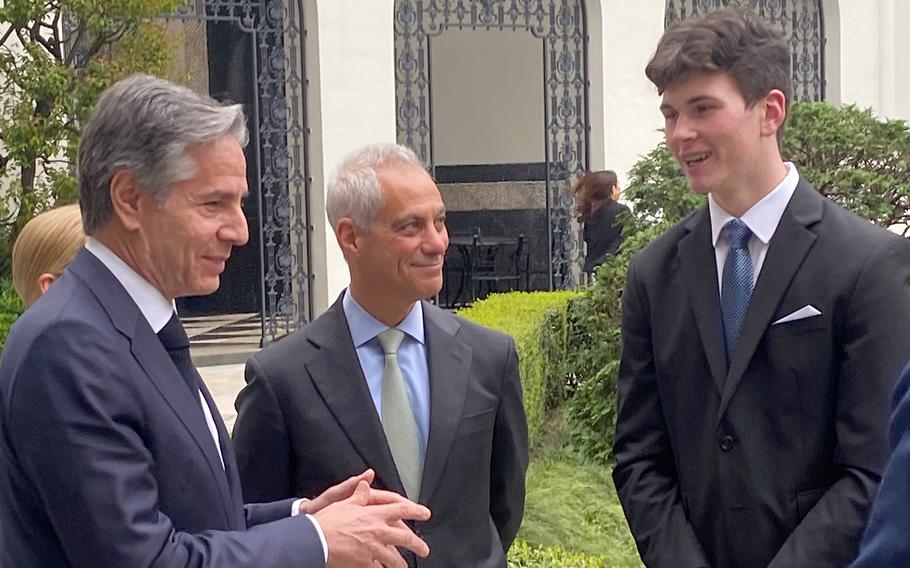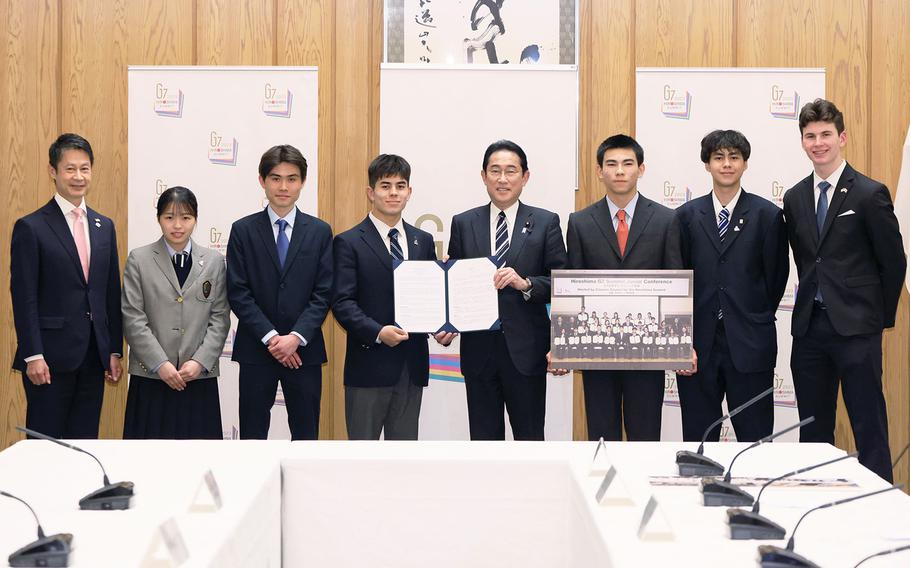
Military teen Aiden O'Reilly discusses his G-7 summit experience with Secretary of State Anthony Blinken, left, and U.S. Ambassador to Japan Rahm Emanuel, center, at the embassy in Tokyo, April 18, 2023. (Aubri O'Reilly)
TOKYO – Aiden O’Reilly was slightly on edge when his turn came to address Japanese Prime Minister Fumio Kishida following the student version of the Group of Seven summit that convenes in Hiroshima later this month.
Aiden, 16, the son of Navy Cmdr. Patrick and Aubri O’Reilly, was among 24 students from around the world, and one of two representing the United States, at the G-7 Hiroshima Summit Junior Conference, March 27-30.
The sophomore at KAIS International School in Tokyo was one of just six students who visited Kishida’s office on April 5 to present position papers from the summit. He delivered a speech on a more sustainable society.
“It was an amazing once-in-a-lifetime moment,” Aiden recently told Stars and Stripes in Tokyo. “I was so grateful for the opportunity to be chosen to go to the prime minister's office and, yes, of course, it was nerve-racking giving him a speech, but once I got into it, it went well and was an incredible experience.”
On April 18, Aiden recounted his conference experience for U.S. Secretary of State Anthony Blinken and U.S. Ambassador to Japan Rahm Emanuel at the embassy in Tokyo, where his father serves as director of capabilities development.
The actual G-7 summit each year brings together leaders of the major industrial nations — the United States, France, the United Kingdom, Germany, Japan, Italy and Canada — to discuss the global economy and regional and global issues. The presidents of the European Council and European Commission also attend. This year’s summit is scheduled for May 19-21 in Hiroshima.

Japanese Prime Minister Fumio Kishida poses with students, including military teen Aiden O’Reilly, far right, who took part in the G-7 Hiroshima Summit Junior Conference, at his office in Tokyo, April 5, 2023. (Prime Minister's Office of Japan)
The junior summit deepened the participating students' understanding of international issues by tackling similar issues.
The students broke into three subject groups — peace, sustainability and diversity and inclusion — with the goal of writing an “outcome document.” Aiden’s group addressed sustainability, with a focus on renewable and nuclear energy and the evolution and future importance of technology.
“When I arrived, I thought there was going to be conflict, and it didn't happen,” he said. “I was so surprised, everybody was like, ‘Look, this is what needs to get done, some of us have different views on things and that's totally fine, let's figure out a collaborative solution to this,’ and it was amazing seeing that happen.”
Aiden’s father said his son, like any military child, grew up at a series of duty stations, including Jacksonville, Fla., Whidbey Island, Wash., and Yokosuka Naval Base, Japan.
“We're incredibly grateful that he participated in this,” Patrick O’Reilly said. “For him to be able to participate with the Japanese government and all the G-7 Partners is a special event for Aiden to be able to see.”
During their conference, the students visited Seifu-shinto Biomass Power Plant and the research and development demonstration base for carbon recycling at Osaki-Kamijima.
“The biofuel plant is focusing on algae-based biofuels, which was amazing to see the production of that,” Aiden said. “It was incredible to see how something like that you would never think that could work could potentially be fueling a plane.”
The students also visited Hiroshima’s Peace Memorial Park, laid flowers at a cenotaph for atomic-bombing victims and heard from a survivor, Keiko Ogura.
“Afterwards we talked about the capabilities of thermonuclear weapons now, compared to what was dropped at that time,” Aiden said. “So, all of us recognized this happened; let's not let it happen again.”
Their visit inspired the conference’s final report, “From Hiroshima to the World.”
“We need to make sure that everyone truly understands the diverse history of Hiroshima and its effects on humanity in order to ensure the tragedy is not repeated,” the document states. “Only by standing in this place and embracing the victims’ experiences can we fully understand how to build a peaceful future together.”
Aiden’s mother said she is incredibly proud of all the hard work her son accomplished with the summit, but also to be selected to participate.
“They are our future generation, our future leaders,” Aubri O’Reilly said. “The world has changed and a lot of problems that we have in the world right now they're going to have to provide the solutions for and this gave them a platform to discuss that.”